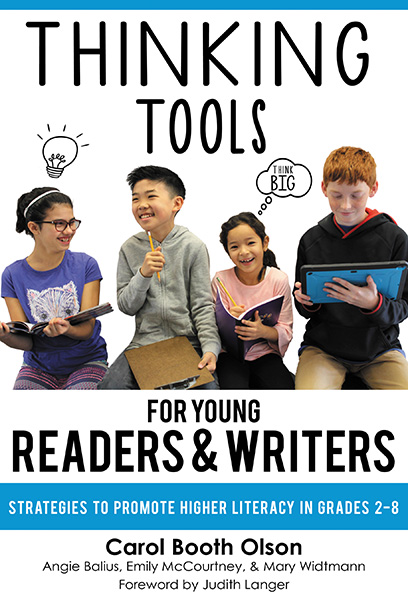Professors: Request an Exam Copy
Print copies available for US orders only. For orders outside the US, see our international distributors.
Carol Booth Olson, Angie Balius, Emily McCourtney, Mary Widtmann
Foreword by: Judith A. Langer
Publication Date: April 6, 2018
Pages: 208

In her new book, bestselling author and professional developer Carol Booth Olson and colleagues show teachers how to help young readers and writers construct meaning from and with texts. This practical resource offers a rich array of research-based teaching strategies, activities, and extended lessons focused on the “thinking tools” employed by experienced readers and writers. It shows teachers how to draw on the natural connections between reading and writing, and how cognitive strategies can be embedded into the teaching of narrative, informational, and argumentative texts. Including artifacts and written work produced by students across the grade levels, the authors connect the cognitive and affective domains for full student engagement. Readers can use this book to:
Book Features:
Carol Booth Olson is director of the UCI/National Writing Project and a professor in the School of Education at the University of California, Irvine. She is coauthor of Helping English Learners to Write—Meeting Common Core Standards, Grades 6–12.
"This book seamlessly bridges the gap from research to everyday practice in grades 2–8. Along with the coauthors of this book, actual in-service teachers were collaborators in this research. All in all, you get an extremely well-organized set of overarching instructional principles that are right for our era and brought to life through well-explained instructional guides and classroom activities."
—From the Foreword by Judith Langer, distinguished professor at the University at Albany, SUNY
“I have always admired Carol Booth Olson’s work with secondary students and teachers. But it is ever so special to see how she and master teacher colleagues apply those essential principles and practices to elementary and middle school students. Bravo!”
—P. David Pearson, professor emeritus, University of California, Berkeley
Tentative Table of Contents
Foreword by Judith Langer
Preface
Chapter 1. Why Use Thinking Tools to Promote Higher Literacy in Grades 2–8?
Reading and Writing Like a Detective: The Mystery Trash Challenge
What Are Students Expected to Know and Be Able to Do as Readers and Writers in Grades 2–8?
Why Take a Cognitive Strategies Approach to Reading and Writing Instruction in Grades 2–8?
Examining the Constraints Faced by Elementary and Middle School Readers and Writers
An Introduction to the Cognitive Strategies Tool Kit
Using the Tool Kit in the Classroom
21st-Century Skills and Technology
To Sum Up
Chapter 2. Best Practices in Reading and Writing Instruction for Students in Grades 2–8
Research on Best Practices for Reading and Writing Instruction in Grades 2–8
Create a Community of Learners
Big Al: A Cognitive Strategies Reading/Writing Tutorial
Using Think-Alouds and Play-Doh to Reinforce Cognitive Strategy Use
Connect Reading and Writing
Model with Mentor Texts
Scaffold Instruction to Lessen the Constraints on Readers and Writers
Offer Frequent Opportunities to Practice Writing Different Text Types Through Writer's Workshop
Provide Explicit Vocabulary Instruction
Administer Formative Assessments
To Sum Up
Chapter 3. Reading and Writing Narrative Texts
Why Prioritize Reading and Writing Narrative Texts in Your Classroom?
The Language Demands of Narrative Texts
Teaching the Elements of Narrative Texts
Narrative Writing Strategies
Putting It All Together: Writing Fictional Narratives
Blending Genres in the Saturation Research Paper
To Sum Up
Chapter 4. Reading and Writing Informative/Expository Texts
The Language Demands of Informative/Expository Texts
Getting Started: Exposing Students to Informational Texts
Teaching Text Structures for Reading and Writing Informative Texts
Teaching Text Structures About Tornadoes
The Initial Report
Writing Wacky Weather Reports: Teaching the 5 Ws + H and Parts of Speech
Informative/Expository Reading and Writing Across the Curriculum
Converting Informative/Expository Reading Into Poetic Writing
Blending Genres: The Robot Lesson
To Sum Up
Chapter 5. Reading and Writing Opinion, Persuasive, Interpretive, and Argumentative Texts
The Challenges of Argumentative Reading and Writing
Teaching Response to Literature: Analyzing Theme in an Interpretive Essay on "Ribbons"
Image Grammar for Sentence Fluency
Helping Students Acknowledge and Refute Counterarguments in Essays Using Multiple Texts
Using Picture Books to Teach Ethos, Pathos, and Logos
Teaching Argument Writing with a Real-World Purpose: A Project-Based Learning Unit on Philanthropy
To Sum Up
Conclusion: Cognitive Strategies Instruction Revisited
References
Index
About the Authors
Professors: Request an Exam Copy
Print copies available for US orders only. For orders outside the US, see our international distributors.